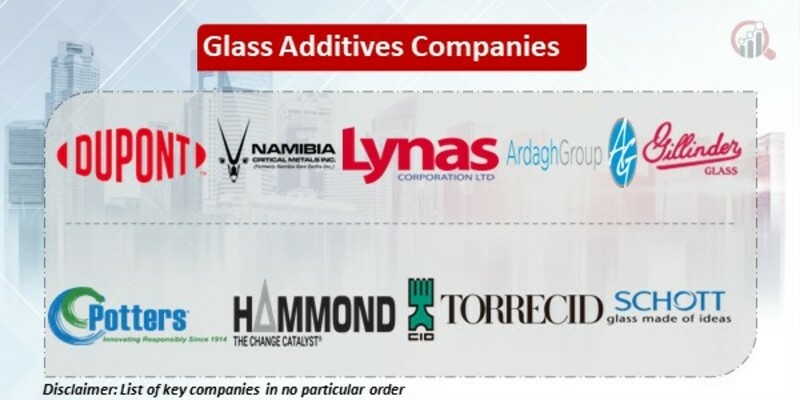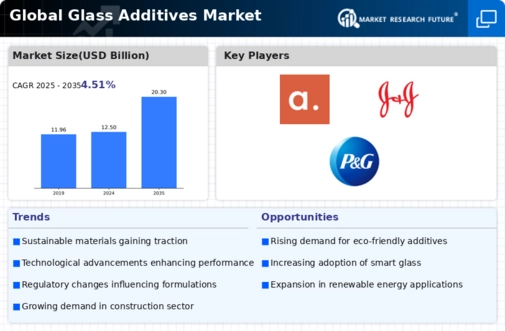Top Industry Leaders in the Glass Additives Market
 The global glass additives market growth is fueled by the increasing demand for advanced glass functionalities across various end-use industries, including construction, automotive, electronics, and pharmaceuticals. Navigating this dynamic landscape requires understanding the key players, their strategies, and the factors that influence market share.
The global glass additives market growth is fueled by the increasing demand for advanced glass functionalities across various end-use industries, including construction, automotive, electronics, and pharmaceuticals. Navigating this dynamic landscape requires understanding the key players, their strategies, and the factors that influence market share.
Leading Players and their Strategies:
-
DuPont: A global leader, DuPont leverages its extensive R&D capabilities to develop innovative glass additives like Opteon™ fluoropolymers for energy-efficient windows and Teflon™ coatings for scratch resistance. Their focus on sustainability and regulatory compliance strengthens their position. -
Torrecid Group: A Spanish multinational, Torrecid specializes in rare earth metal oxides and their applications in glass additives. Their recent acquisition of Molycorp Minerals further bolsters their access to raw materials and production capacity. -
BASF SE: A German chemical giant, BASF offers a diverse portfolio of glass additives, including colorants, strengthening agents, and conductivity enhancers. Their focus on regional expansion and strategic partnerships with glass manufacturers helps them maintain market share. -
Bayer Material Science: Another German player, Bayer MaterialScience excels in developing specialty glass additives with unique properties like self-cleaning and UV protection. Their strong presence in the automotive and electronics industries strengthens their position. -
Nanobase: A relatively new player, Nanobase specializes in nano-engineered glass additives offering superior properties like scratch resistance and thermal insulation. Their focus on niche applications and collaborations with research institutions fuels their growth.
Factors Influencing Market Share:
-
Product Portfolio and Innovation: Offering a diverse range of additives catering to specific end-use requirements and actively developing innovative solutions are crucial for gaining market share. -
Manufacturing and Distribution Network: A robust and efficient manufacturing and distribution network ensures timely delivery and cost-effectiveness, attracting customers. -
Brand Reputation and Customer Trust: Building a strong brand reputation for quality, reliability, and technical expertise fosters customer loyalty and repeat business. -
Regulatory Compliance: Stringent regulations in some regions necessitate expertise in navigating compliance processes, offering an advantage to established players. -
Sustainability and Environmental Impact: Promoting eco-friendly additives and minimizing environmental impact through responsible manufacturing practices resonates with environmentally conscious customers.
Key Players
Some of the prominent players operating in the Global Glass Additives Market are Namibia Rare Earths Inc. (Canada), Lynas Corporation Ltd (Australia), Torrecid Group (Spain), Potters Industries LLC (U.S.), SCHOTT AG (Germany), DuPont. (U.S.), GILLINDER GLASS (U.S.), METALL RARE EARTH LIMITED (China), Ardagh Group (Republic of Ireland), HAMMOND GROUP INC (U.S.) among others.
Recent Developments:
-
September 2023: AGC Inc., a Japanese glass manufacturer, launches a new line of UV-protective glass additives for automotive applications, targeting the growing demand for sunroofs and windshield protection. -
October 2023: Saint-Gobain, a French multinational building materials company, partners with a startup developing bio-based glass additives as a sustainable alternative to traditional additives. -
November 2023: The Chinese government announces plans to invest in research and development of next-generation glass additives, aiming to become a leader in this technology. -
December 2023: A consortium of European research institutions receives funding to develop a new type of glass additive that can store and release energy, paving the way for energy-harvesting windows.









